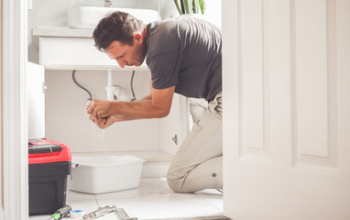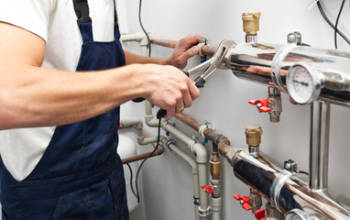A plumbing system carries fresh water into buildings, removing waste and sewage. Plumber Granada Hills maintains these systems, keeping them functioning properly and efficiently.
A career in plumbing begins with technical courses at a trade school or community college, followed by a learn-while-you-earn apprenticeship. Once licensed, a plumber works with many systems in homes and businesses.
The water supply is the infrastructure for the collection, transmission, treatment, storage, and distribution of potable (drinking) water for use in homes and businesses and for public needs like street flushing and fire fighting. It includes the sources from which water is drawn and any facilities for storing and supplying this water, such as reservoirs and pipelines. In some areas, this system may also include the distribution of sewage and other wastes to wastewater plants and reuse of treated water for irrigation or drinking. Water supplies are often regulated by local, state and federal governments as part of the public utilities industry.
The infrastructure that collects, transports, treats, stores, and distributes potable (drinking) water for use in residences and commercial buildings as well as for public uses like fighting fires and flushing streets is known as the water supply. It comprises the water sources as well as any infrastructure—such as pipelines and reservoirs—that is used to supply and store the water. Reusing treated water for drinking or irrigation, as well as distributing sewage and other wastes to wastewater treatment facilities, may be additional components of this system in some places. As part of the public utilities sector, local, state, and federal governments frequently regulate water supplies.
Most people get their drinking water from public water-supply agencies, such as county governments in the These water-supply systems are designed to find and transport water to a community, whether it is groundwater, surface water or seawater. Once the water is treated, it is delivered to the distribution system via supply conduits, such as pipes or aqueducts. The conduits are often designed in a grid to avoid dead ends and ensure the circulating system is capable of servicing all consumers, even if sections of the system are shut down for maintenance or repair. These systems may also be equipped with a network of pumps to pressurize the water for delivery, if needed.
In the the majority of people obtain their drinking water from public water supply organizations like county governments. These water delivery systems are made to locate and deliver water—be it seawater, surface water, or groundwater—to a community. After being cleaned, the water is sent via supply conduits like pipes or aqueducts to the distribution system. In order to prevent dead ends and guarantee that the circulating system can serve every customer, even when portions of the system are unavailable for maintenance or repair, the conduits are frequently constructed in a grid pattern. If necessary, a network of pumps may be included in these systems to pressurize the water before it is delivered.
This network of pipes can be subject to contamination from the environment, from toxins and from other sources in the supply chain, such as from livestock or human beings. In addition, contaminants can enter the water supply through cross-connections, which is any direct or indirect physical connection that permits nonpotable water or other sources of questionable or known poor quality to contaminate the potable supply. The source of the contaminated water can be either within the distribution system itself or at the consumer’s home, through a defect in plumbing.
This pipe network is susceptible to pollution from the surrounding environment, pollutants, and other supply chain sources like people or animals. Cross-connections, which are any direct or indirect physical connections that allow nonpotable water or other sources of dubious or known poor quality to contaminate the potable supply, are another way that pollutants can get into the water system. The source of the tainted water may be a plumbing issue at the customer’s house or within the distribution system itself.
In the building construction industry, the water supply is referred to as the “water service”. In many cases, it is the plumbing contractor’s responsibility to install this system and to maintain it during occupancy. This is a complex undertaking that must comply with all applicable codes, including those from the City Department of Environmental Protection and the Building Code, State Energy Research and Development Authority rules and regulations, and the National Plumbing Code.
The drainage system carries away wastewater and sewage from the house, including washrooms, kitchen, laundry room, and any other appliances that use water. It consists of pipes, drain traps, and vents that connect to the sewer line or septic tank. The drainage system also includes gutters and downspouts to direct rainwater away from the building.
A drainage system is important for preventing flooding and soil erosion around a building site. It also helps maintain healthy plant growth by ensuring that roots have access to oxygen in the soil, which is essential for their survival. Without proper drainage, plants may become water-logged, leading to rot and other problems. Drainage systems also protect against groundwater contamination by preventing pollutants from seeping into the groundwater supply.
Unlike the plumbing system, which uses pressure to transport water, the drainage system relies on gravity to remove waste water from the home. This is because the drainage pipes are angled downward, allowing them to play off of the slope of the land. The pipes are also larger than those used in the plumbing system, allowing them to carry more volume. Another key component of the drainage system is the drain trap, which prevents backflow in the pipes and keeps odor-causing sewer gases from entering the living spaces.
While the drainage and plumbing systems are distinct, they do have some bridges. Plumbers refer to these bridges as fixtures, and they include any point where clean water enters the home or wastewater leaves it. For example, the drains in sinks, bathtubs, and showers are all considered fixtures.
The drainage and plumbing systems are crucial for keeping homes safe and comfortable. Regular maintenance and being careful about what goes into the pipes can help avoid clogs, which are a common problem in many households. For major repairs, it’s important to work with a licensed and experienced plumber. With the right skills and knowledge, a plumber can ensure that your home’s plumbing system is working properly. Contact a plumbing company for more information about their services and to find out how they can help you with your plumbing needs.
Plumbing is one of the most important aspects of building construction. It ensures that the occupants of a structure have access to clean water and can dispose of waste effectively. Without proper plumbing, a building can quickly become unusable or even dangerous. For this reason, it is crucial to work with skilled plumbing contractors when building a new structure.
Plumbing systems consist of carefully constructed piping networks that distribute drinking water to faucets, basins, tubs, showers, and washing machines throughout a building. They also remove wastewater and other liquid wastes from buildings and transport them to sewer systems or wastewater treatment plants. In addition, plumbing systems can heat and cool water for use in heating and cooling systems.
The first step in installing a plumbing system is creating a blueprint of the building’s layout and determining where pipes will be installed. Then, plumbing professionals will cut and connect the pipes using various fittings. After the system is in place, workers will test it for leaks and other issues. Finally, they will install devices like toilets, urinals, and lavatories.
In modern buildings, plumbing is integrated with electrical and fire safety systems. This makes it easier to maintain and upgrade all of these important systems at once, rather than separately. In addition, plumbing can help reduce a building’s energy costs by increasing its efficiency. This is especially important in regions with high energy prices.
Plumbing is a complex and essential part of any building. It’s responsible for distributing water, disposing of waste, and heating and cooling the structure. Without it, a building would not be usable or safe for its occupants. To learn more about plumbing and how it works, contact a qualified plumber today.



